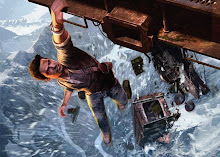What Would Batman Do?
Game Director Sefton Hill made the directive right at the beginning of the 'Batman: Arkham Asylum' project that every aspect of the project - from the game design through to the art had to be true to the Batman Universe and to Batman's own personality characteristics. "We based all our decisions around this simple principle," says Hill. "This made life a lot easier for us as it gave us a touchstone that would let us know if we were ever going off track, all we had to ask was, 'What would Batman do?' This resulted in the final product being true to the Batman brand, and produced a rich authentic experience for both the Batman disciple and those new to the caped crusader."
Lead Character Artist for the 'Batman Arkham Asylum' game, Andrew Coombes, walked in from a traditional fine arts background, even training as a sculptor. Over the years, he's worked in a variety of art fields from a bronze foundry in East London, sculpting ten metre high street floats for Disneyland Paris Millennium Parade, then working on the 'Lord of the Rings' trilogy. "I have been in the games industry for the last seven years," says Coombes, "the last four years spent at Rocksteady. When I started in 2005 there was thirty staff which has steadily grown to over seventy."
Rocksteady
Rocksteady Studio was opened in 2004. The company is based in Highgate, North London in a converted factory, purpose-built for making games. "It is by far the most enjoyable place I have worked and much of that is down to the efforts of the directors Jamie Walker and Sefton Hill, both industry veterans, who make the studio a place where you want to be," explains Coombes.
"The studio is fitted with a motion capture stage including full facial capture capabilities, and a sound studio. This means that we can produce every element required for our projects on site when we need them, without having to rely on external support. This allows us to prototype and experiment with ideas very quickly and produces a more refined final product as a result," adds Coombes.
"There is a strong emphasis on smart scheduling and constant self reflection to keep our projects on course and on time, this is a major factor in Rocksteady's ongoing reliability and success."
The main work area is a huge open-plan plant filled space where the entire team works together. The open plan approach helps people from all departments to communicate more effectively.
Environments
On the art side our process began with us scouring the graphic novels for inspiration. We looked at the Batman comics down through the decades paying close attention to the Arkham specific books like the beautiful 'Arkham Asylum: A Serious House on Serious Earth', and 'Arkham Asylum: Living Hell'.
Arkham had never been visualised in its entirety before so the environment team had the big challenge of creating every nook and cranny of the island for the first time. Arkham Asylum is an amazing place to set a Batman game. It gave us not only an environment, that from a technical and game play standpoint was suited to our design, being of a finite, contained size with believable borders, but it also gave us a setting so rich in creepy, foreboding atmosphere that it was an artist's dream location.
The Art Director Dave Hego had a very strong vision that Arkham should be like a living breathing character in itself that changes as time passes, that slips from dark reality to darker nightmare as Batman slides into the Scarecrow sequences, and that evolves as The Joker's plan unfolds.
Arkham is an island with a history and its buildings reflect this in the way they have been adapted over time to suit the needs of the Asylum, the architecture of one era juxtaposed with that of the next. This layering of architecture creates the richness and uniqueness you see in the game, from the Gothic architecture of the Main Hall, to the Victorian style of the glasshouses, to the dingy industrial warehouse feel of high security.
"We tried to use real places where possible as reference for our environments," explains Dave Hago, "an example of this being The Arkham Botanical Gardens which are inspired by the Palm House at Kew Gardens in South London.
The environment team spent time there gathering reference material in the beautiful Victorian glasshouses. We found this type of exercise invaluable in creating highly detailed environments that had a feeling of authenticity. We also used Alcatraz the real world equivalent of Arkham as another source of inspiration."
Unreal Engine
Rocksteady used the Unreal Engine for 'Batman Arkham Asylum'. They've been using Unreal for a year and a half on an unreleased title before starting on 'Batman'. During this time, they worked out how to get the most out of the engine and set up a solid pipeline.
So they hit the ground running when 'Batman:AA' came along, and moved quickly from preproduction into production."It was a pleasure to work with Unreal," says Coombes. "It allows a level of freedom to experiment without code assistance that I haven't experienced before. In particular the material editor is very powerful, and the node based system has a huge amount of scope."
Characters
Creating the characters for 'Batman Arkham Asylum' was both daunting and exciting privilege for the team. There is such an enormous history to these characters."We combined the stylisation and exaggeration of the graphic novels with highly detailed realistic rendering and lighting," Coombes explains. "We tried to be as true to the comics as we could while at the same time making the characters fit with the dark gritty atmosphere of the Asylum that we envisioned."
To be Continued...














































